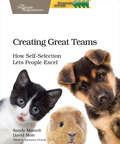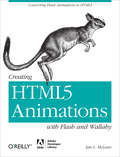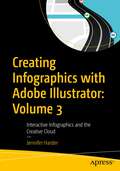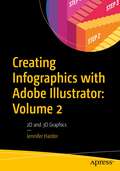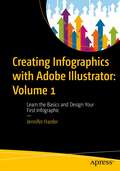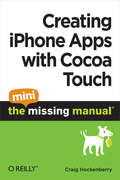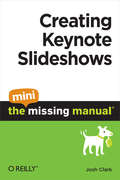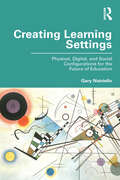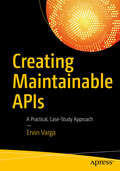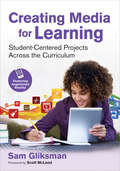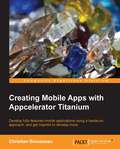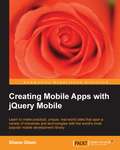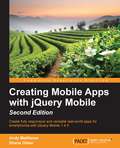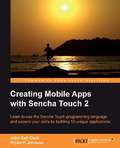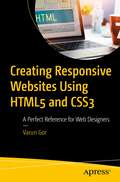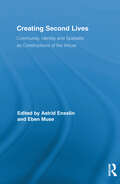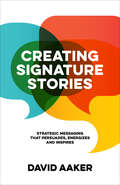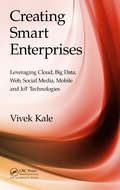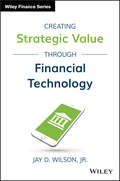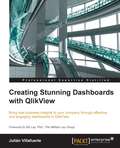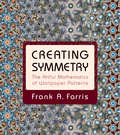- Table View
- List View
Creating Great Teams: How Self-Selection Lets People Excel
by Sandy Mamoli David MolePeople are happiest and most productive if they can choose what they work on and who they work with. Self-selecting teams give people that choice. Build well-designed and efficient teams to get the most out of your organization, with step-by-step instructions on how to set up teams quickly and efficiently. You'll create a process that works for you, whether you need to form teams from scratch, improve the design of existing teams, or are on the verge of a big team re-shuffle. Discover how New Zealand's biggest e-commerce company completely restructured their business through Self-Selection. In the process, find out how to create high-performing groups by letting people self-organize into small, cross-functional teams. Step-by-step guides, easy-to-follow diagrams, practical examples, checklists, and tools will enable you to run a Self-Selection process within your organization.If you're a manager who wants to structure your organization into small teams, you'll discover why Self-Selection is the fastest and safest way to do so. You'll prepare for and organize a Self-Selection event and make sure your Self-Selection participants and fellow managers are on board and ready. If you're a team member, you'll discover what it feels like to be part of a Self-Selection process and what the consequences are for your daily work. You'll learn how to influence your colleagues and bosses to be open to the idea of Self-Selection. You'll provide your manager with a plan for how to facilitate a Self-Selection event, and with evidence that the system works.If you're feeling the pain and chaos of adding new people to your organization, or just want to ensure that your teams have the right people with the right skills, Self-Selection will help you create the effective teams you need.
Creating HTML5 Animations with Flash and Wallaby: Converting Flash Animations to HTML5 (Oreilly And Associate Ser.)
by Ian L. Mclean<p>Learn how to use Flash and Wallaby to streamline the process of creating HTML5 animations that can run on a broad range browsers of devices.</p>
Creating Infographics with Adobe Illustrator: Interactive Infographics and the Creative Cloud
by Jennifer HarderThis full-color book, the third of three volumes, focuses on Adobe Illustrator’s SVG interactivity tools. How can an infographic be made more interactive for an audience? What additional Illustrator tools and Adobe applications can be used to enhance your infographic layout? In this final volume of Creating Infographics with Adobe Illustrator, you will learn the answers to all these questions. Author Jennifer Harder will walk you through creating basic infographics in Illustrator using Illustrator tools for creating SVG files, known as Scalable Vector Graphics, for basic Interactivity on a web page. Then you will review layouts in other Adobe Applications in relation to their connectivity with Illustrator. Upon completing this volume, you will have a thorough understanding of how to design an infographic with basic interactivity for a web page, and how this can improve visualization and convey meaning to your audience. Moreover, you will be able to use this knowledge to create your own infographics using Illustrator’s wide array of tools. What You Will Learn Discover how to apply interactivity to an infographicGain insight into different infographic layouts and how to finalize your project with your clientExplore other Adobe Creative Cloud applications that may assist you in the future as you create your infographics Who This Book Is For Beginner-level designers and others who are interested in learning the process of creating infographics for their company, the classroom, for, an article in a magazine, or adding interactivity to webpage.
Creating Infographics with Adobe Illustrator: 2D and 3D Graphics
by Jennifer HarderThis full-color book will teach you how to use Adobe Illustrator's various tools to create infographics, as well as basic page layouts for them. It focuses on Illustrator’s powerful graphing tools and 2D and 3D effects. How can an infographic or graph be altered and adapted to appear more engaging and still display your data accurately? What additional effects can be used on your infographic to produce the results you envision? In this second volume of Creating Infographics with Adobe Illustrator, you will learn the answers to all these questions. Author Jennifer Harder will walk you through creating basic infographics in Illustrator using Illustrator tools such as Graphing Tools as well as how to create 2D effects and 3D shapes with their related materials, including Symbols. Upon completing this volume, you will have an appreciation for how easy it is to design an infographic or graph to display your data and discover how rudimentary shapes and colors can be altered using patterns, as well as 2D and 3D effects, to enhance readability while conveying meaning to your audience. You will be able to use this knowledge to create your own infographics using Illustrator’s wide array of tools. What You Will Learn Use Illustrator’s Graphing Tools to create and modify basic charts or graphsWork with popular 2D effects to enhance your design in IllustratorCreate 3D Shapes using Materials and Symbols and modify your 3D GraphsExplore basic Image Trace and Perspective options in Illustrator Who This Book Is For Beginner-level designers and others who are interested in learning the process of creating infographics for their company, the classroom, for data visualization, an article in a magazine, or a webpage.
Creating Infographics with Adobe Illustrator: Learn the Basics and Design Your First Infographic
by Jennifer HarderThis full-color book will teach you how to use Adobe Illustrator's various tools to create infographics, as well as basic page layouts for them. This is the first of three volumes which will cover all the fundamentals of Illustrator, an industry standard application used by graphic designers and marketing and communication teams. How is an infographic different from a logo or any other illustration? What additional thought processes, skills, or software tools should be utilized to create an infographic? In this first volume of Illustrator Basics, you will learn the answers to all these questions. Author Jennifer Harder will walk you through creating basic infographics in Illustrator using Basic Shape tools, Pen Tools, Type Tools, and Symbols. Upon completing this volume, you will have an appreciation for how easy it is to design an infographic and discover how rudimentary shapes and colors can affect readability while conveying meaning to your audience. You will be able to use this knowledge to create your own infographics using Illustrator’s wide array of tools. Who This Book Is For Discover the tools within Illustrator that are ideal for creating basic infographicsDevelop a logo based upon a scanned sketchGain an understanding of different infographic layouts and the process of reviewing them with your client Who This Book Is For Beginner-level designers and others who are interested in learning the process of creating infographics for their company, the classroom, for a visual resume, an article in a magazine, or a webpage.
Creating iPhone Apps with Cocoa Touch: The Mini Missing Manual
by Craig HockenberryCreating iPhone Apps with Cocoa Touch: The Mini Missing Manual walks you through developing your first iPhone App and introduces you to your programming environments and tools: Cocoa Touch, Interface Builder, Xcode, and the Objective-C programming language. If you're a Java or C developer, this eBook is your fast track to App development. This eBook is adapted from parts of iPhone App Development: The Missing Manual.
Creating Keynote Slideshows: The Mini Missing Manual
by Josh ClarkDon't bore your audience with black bullet points on a white background. Your ideas deserve a presentation that's as smart and elegant as they are. Even if you're new to the Mac, this hands-on guide gets you up to speed on Keynote's features-like timesaving themes-fast. You'll learn how to customize layouts to your liking and add even more flash with sound and video.
Creating Keynote Slideshows: The Mini Missing Manual
by Josh ClarkDon't bore your audience with black bullet points on a white background. Your ideas deserve a presentation that's as smart and elegant as they are. Even if you're new to the Mac, this hands-on guide gets you up to speed on Keynote's features-like time saving themes- fast. You'll learn how to customize layouts to your liking and add even more flash with sound and video.
Creating Learning Settings: Physical, Digital, and Social Configurations for the Future of Education
by Gary NatrielloCreating Learning Settings examines the design and implementation of learning settings informed by the newest, most expansive insights into how people learn in the post-industrial age. Educators today are tasked with moving beyond the fixed, traditional practices that have long dominated formal schooling and becoming more dynamic and strategic in arranging learners, facilitators, resources, on-site and virtual environments, and learning experiences. Integrating contemporary theoretical approaches and empirical studies, this book offers a systematic approach to creating settings that leverage the physical, digital, resource, and social dimensions necessary to support learning.
Creating Maintainable APIs: A Practical, Case-Study Approach
by Ervin VargaBuild straightforward and maintainable APIs to create services that are usable and maintainable. Although this book focuses on distributed services, it also emphasizes how the core principles apply even to pure OOD and OOP constructs. The overall context of Creating Maintainable APIs is to classify the topics into four main areas: classes and interfaces, HTTP REST APIs, messaging APIs, and message payloads (XML, JSON and JSON API as well as Apache Avro). What You Will Learn Use object-oriented design constructs and their APIs Create and manage HTTP REST APIs Build and manage maintainable messaging APIs, including the use of Apache Kafka as a principal messaging hub Handle message payloads via JSON Who This Book Is For Any level software engineers and very experienced programmers.
Creating Media for Learning: Student-Centered Projects Across the Curriculum
by Sam GliksmanHelp Students Show Learning Through Media Creation Education hinges on effective communication. This book demonstrates how media has become a core component of modern communication and highlights the need to incorporate student-centered media projects throughout the curriculum. Self-expression with media will enhance the learning process and allow students to creatively demonstrate their knowledge. The strategies and tactics these pages offer equip educators to make their students enthusiastic experts at producing dynamic media projects. Content includes: The how, why, and when of prompting students to create their own media across subjects and grade levels. Keys to mastery of media formats from simple photography to eBooks to complex animations. Detailed descriptions of student projects that utilize different media. The benefits of media sharing, and how to do it responsibly. The innovative use of Augmented Reality, so readers can activate a video on the book’s printed pages with their mobile devices. Across all disciplines, mastery of media creation is central to the success of current and next generation students. Educators who implement this book’s ideas will be amazed by the resultant increase in student engagement and depth of learning. "What a thoughtful collection of student-created products. This book highlights a variety of multimedia projects, offers a multitude of best practices and practical implementation tips, and is sure to empower teachers to help students find their voice." Lisa Johnson, Eanes ISD Ed Tech @TechChef4u
Creating Media for Learning: Student-Centered Projects Across the Curriculum
by Sam GliksmanHelp Students Show Learning Through Media Creation Education hinges on effective communication. This book demonstrates how media has become a core component of modern communication and highlights the need to incorporate student-centered media projects throughout the curriculum. Self-expression with media will enhance the learning process and allow students to creatively demonstrate their knowledge. The strategies and tactics these pages offer equip educators to make their students enthusiastic experts at producing dynamic media projects. Content includes: The how, why, and when of prompting students to create their own media across subjects and grade levels. Keys to mastery of media formats from simple photography to eBooks to complex animations. Detailed descriptions of student projects that utilize different media. The benefits of media sharing, and how to do it responsibly. The innovative use of Augmented Reality, so readers can activate a video on the book’s printed pages with their mobile devices. Across all disciplines, mastery of media creation is central to the success of current and next generation students. Educators who implement this book’s ideas will be amazed by the resultant increase in student engagement and depth of learning. "What a thoughtful collection of student-created products. This book highlights a variety of multimedia projects, offers a multitude of best practices and practical implementation tips, and is sure to empower teachers to help students find their voice." Lisa Johnson, Eanes ISD Ed Tech @TechChef4u
Creating Mobile Apps with Appcelerator Titanium
by Christian BrousseauCreating Mobile Apps with Appcelerator Titanium provides a hands-on approach and working examples on creating apps and games as well as embedding them onto a social networking website. Developers can then move on from there to develop their own applications based on the ones they have developed throughout the course of this book."Creating Mobile Apps with Appcelerator Titanium" is for developers who have experience with modern languages and development environments. Also, if you are familiar with the concepts of Object-oriented Programming (OOP), reusable components, AJAX closures, and so on, this book will help you leverage that knowledge in mobile development.This book will also cater to Titanium users who wish to know more about Titanium's broad range of capabilities and will help you to expand Titanium's basic set of features by using extension modules.
Creating Mobile Apps with jQuery Mobile
by Shane GliserWith ample coded examples and screenshots, the book consists of 10 different projects that will help you master jQuery Mobile. "Creating Mobile Apps with jQuery Mobile" assumes a base level knowledge of web development. If you've used jQuery Mobile before, you're gold. Otherwise, you can pick it up along the way.
Creating Mobile Apps with jQuery Mobile - Second Edition
by Shane Gliser Andy MatthewsThis book assumes a basic level of experience with standard web development. If you've used jQuery Mobile before, you're good to go. Otherwise, you can pick it up along the way.
Creating Mobile Apps with Sencha Touch 2
by Bryan P. Johnson John E. ClarkFull of explained code and enriched with screenshots, this book is the practical way to take your Sencha Touch skills to the next level. This book is aimed at people who have a basic to intermediate understanding of Sencha Touch. If you understand the basic concepts, but you need to see how it all fits together, then this book is for you.
Creating New Medical Ontologies for Image Annotation: A Case Study (SpringerBriefs in Electrical and Computer Engineering)
by Liana Stanescu Dumitru Dan Burdescu Marius Brezovan Cristian Gabriel MihaiCreating New Medical Ontologies for Image Annotation focuses on the problem of the medical images automatic annotation process, which is solved in an original manner by the authors. All the steps of this process are described in detail with algorithms, experiments and results. The original algorithms proposed by authors are compared with other efficient similar algorithms. In addition, the authors treat the problem of creating ontologies in an automatic way, starting from Medical Subject Headings (MESH). They have presented some efficient and relevant annotation models and also the basics of the annotation model used by the proposed system: Cross Media Relevance Models. Based on a text query the system will retrieve the images that contain objects described by the keywords.
Creating Responsive Websites Using HTML5 and CSS3: A Perfect Reference for Web Designers
by Varun GorLearn to implement web designs using HTML5 and CSS3. This book focuses on the need for responsive web design and how you can leverage HTML5 and CSS3 to create interactive websites that work in the real world. You do not need be a technology expert or have a prior coding background to benefit from this book. All you need is a want to learn and a curious mind to explore the full spectrum of features HTML5 and CSS3 have to offer.You'll see how to migrate legacy websites to responsive websites in a very easy-to-understand, step-by-step, manner. Additionally, you will learn to use supportive software to create, run, and debug any issues that may arise during the development process. This book will also show you how to implement websites that work on multiple devices, and on various browsers such as Opera, Chrome, internet Explorer, or Edge. All this will be explored with supporting files, open-source software, as well as a practical guide to creating your demo website along with learning new technologies.From the basics to more advanced topics, Creating Responsive Websites Using HTML and CSS is for anyone who wants to learn about and build beautiful responsive websites. What You'll LearnCode and design websites using HTML5 and CSS3 Design professional-looking websites using colors, margins, images, and other aspectsCreate a responsive design that will work on laptops, PCs, and any kind of mobile deviceTroubleshoot and fix code errors independently using developer toolsSolve cross-browser responsiveness issues and the challenges that come with different operating systemsWho This Book Is ForStudents and/or website designers who want to upskill their talents
Creating Second Lives: Community, Identity and Spatiality as Constructions of the Virtual (Routledge Studies in New Media and Cyberculture)
by Astrid Ensslin Eben MuseThis book aims to provide insights into how ‘second lives’ in the sense of virtual identities and communities are constructed textually, semiotically and discursively, specifically in the online environment Second Life and Massively Multiplayer Online Games such as World of Warcraft. The book’s philosophy is multi-disciplinary and its goal is to explore the question of how we as gamers and residents of virtual worlds construct alternative online realities in a variety of ways. Of particular significance to this endeavour are conceptions of the body in cyberspace and of spatiality, which manifests itself in ‘natural’ and built environments as well as the triad of space, place and landscape. The contributors’ disciplinary backgrounds include media, communication, cultural and literary studies, and they examine issues of reception and production, identity, community, gender, spatiality, natural and built environments using a plethora of methodological approaches ranging from theoretical and philosophical contemplation through social semiotics to corpus-based discourse analysis.
Creating Signature Stories: Strategic Messaging that Persuades, Energizes and Inspires
by David AakerStories are orders of magnitude which are more effective than facts at achieving attention, persuading, being remembered, and inspiring involvement. Signature stories—intriguing, authentic, and involving narratives—apply the power of stories to communicate a strategic message. Marketing professionals, coping with the digital revolution and the need to have their strategic message heard internally and externally, are realizing that a digital strategy revolves around content and that content is stories.Creating Signature Stories shows organizations how to introduce storytelling into their strategic messaging, and guides organizations to find, or even create, signature stories and leverage them over time. With case studies built into every chapter, organizations will realize the power of storytelling to energize readers, gain visibility, persuade audiences, and inspire action.
Creating Smart Enterprises: Leveraging Cloud, Big Data, Web, Social Media, Mobile and IoT Technologies
by Vivek Kale"Vivek Kale's Creating Smart Enterprises goes smack-dab at the heart of harnessing technology for competing in today's chaotic digital era. Actually, for him, it's SMACT-dab: SMACT (Social media, Mobile, Analytics and big data, Cloud computing, and internet of Things) technologies. This book is required reading for those that want to stay relevant and win, and optional for those that don't." —Peter Fingar, Author of Cognitive Computing and business technology consultant Creating Smart Enterprises unravels the mystery of social media, mobile, analytics and big data, cloud, and Internet of Things (SMACT) computing and explains how it can transform the operating context of business enterprises. It provides a clear understanding of what SMACT really means, what it can do for smart enterprises, and application areas where it is practical to use them. All IT professionals who are involved with any aspect of a SMACT computing project will profit by using this book as a roadmap to make a more meaningful contribution to the success of their computing initiatives. This pragmatic book: Introduces the VUCA (volatility, uncertainty, complexity, and ambiguity) business ecosystem confronted by the businesses today. Describes the challenges of defining business and IT strategies and of aligning them as well as their impact on enterprise governance. Provides a very wide treatment of the various components of SMACT computing, including the Internet of Things (IoT) and its constituting technologies like RFID, wireless networks, sensors, and wireless sensor networks (WSNs). This book addresses the key differentiator of SMACT computing environments and solutions that combine the power of an elastic infrastructure with analytics. The SMACT environment is cloud-based and inherently mobile. Information management processes can analyze and discern recurring patterns in colossal pools of operational and transactional data. Analytics, big data, and IoT computing leverage and transform these data patterns to help create successful, smart enterprises.
Creating Stellar Lessons with Digital Tools: From Integration to Innovation in Technology-Enhanced Teaching
by Kenneth J. LuterbachCreating Stellar Lessons with Digital Tools prepares teachers in training and in-service teachers to use technologies for design and development activities with middle and high school students. While software, open resources, handheld devices, and other tools hold great potential to enhance learning experiences, teachers themselves must model technology use in ways that inspire students to become producers and leaders rather than consumers and followers. Featuring concrete applications in social studies, English, mathematics, and science scenarios, this book provides pre-service teachers with seven paths to creatively integrate and innovate with computational thinking, datasets, maker spaces, visual design, media editing, and other approaches.
Creating Strategic Value through Financial Technology
by Jay D. Wilson Jr.Lessons in innovation from key FinTech trends and successes Creating Strategic Value through Financial Technology explores the growing Financial Technology (FinTech) industry to provide insight on how traditional financial institutions and FinTech companies can boost innovation and enhance valuation in a complex regulatory environment. In plumbing the depth and breadth of several niches within in the FinTech sector, author Jay Wilson uncovers key themes that have contributed to the industry's success; in this book, he maps them together to provide useful guideposts for investors, entrepreneurs, and traditional institutions looking to facilitate growth as technology and financial services collide. With an expert's perspective on FinTech history and outlook, certain trends and examples of value-enhancing strategies stand out. FinTech niches covered include: payments, crowdfunding, alternative/marketplace lending, the blockchain, and technology solutions in the context of banking, insurance, and investment companies. There is no denying the growing importance of technology in the financial services industry, and the FinTech sector offers valuable solutions for a diverse array of financial services providers and their customers. This book guides you through several niches of the FinTech sector, and highlights the most important takeaways from recent endeavors. Navigate the financial technology sector Enhance customer and product offerings Improve efficiency and cost structure Enhance profitability and company valuation from the intersection of technology and finance Innovation and customer preference is a key driver of FinTech's growth. Customers are demanding better value and convenience, and the organizations that provide it are reaping the rewards of growth. As financial regulations grow more and more complex, and customers are presented with more and more options, it is becoming imperative for traditional institutions to modernize processes and carve out a place in the future of financial services. Creating Strategic Value through Financial Technology provides a handbook for navigating that space, with practical guidance on how FinTech companies and traditional financial institutions can enhance profitability and valuation from the trends.
Creating Stunning Dashboards with QlikView
by Julian VillafuerteBring real business insights to your company through effective and engaging dashboards in QlikViewAbout This BookBuild outstanding dashboards that respond to your company's information needsPresent the data in efficient and innovative ways to promote insightsUnleash the true power of QlikView by creating engaging visualizationsWho This Book Is ForThis book is focused on QlikView developers with basic knowledge of scripting and layouts who want to improve their designing skills and build effective, eye-catching dashboards that deliver tangible value to their business.What You Will LearnBuild a comprehensive library of QlikView components to speed up your developmentsDefine a practical roadmap that will help you build business-driven dashboardsExplore the most effective and engaging ways to present dataApply the best practices in the field of data visualizationAvoid common pitfalls when creating bar, line and pie chartsCreate robust visualizations such as heat maps, histograms and scatter plotsIn DetailQlikView is one of the most powerful analytical tools in the market. Based on an in-memory associative model, it lets users freely navigate through the data, spot trends and make better decisions. This platform is capable of integrating a wide range of data sources like ERP systems, data warehouses or spreadsheets into a single application in order display dashboards with state-of-the-art visualizations.Creating Stunning Dashboards with QlikView is an easy to follow handbook that guides you through the process of creating an effective and engaging dashboard that delivers tangible value to the business. It starts with the identification of the business needs and the definition of the main KPIs, and takes you all the way to the application rollout.Throughout the book, you will learn how to apply some of the best practices in the field of data visualization, create a robust navigation schema, chose the best chart types for each scenario and many other things that will help you create effective dashboards that uncover all the stories behind the data.Style and approachThis easy-to-follow compilation of best practices, tips, and tricks will help you leverage your QlikView developments. Each section presents practical guidelines to help you create dashboards that are not only functional, but also engaging and compelling.
Creating Symmetry
by Frank A. FarrisThis lavishly illustrated book provides a hands-on, step-by-step introduction to the intriguing mathematics of symmetry. Instead of breaking up patterns into blocks--a sort of potato-stamp method--Frank Farris offers a completely new waveform approach that enables you to create an endless variety of rosettes, friezes, and wallpaper patterns: dazzling art images where the beauty of nature meets the precision of mathematics.Featuring more than 100 stunning color illustrations and requiring only a modest background in math, Creating Symmetry begins by addressing the enigma of a simple curve, whose curious symmetry seems unexplained by its formula. Farris describes how complex numbers unlock the mystery, and how they lead to the next steps on an engaging path to constructing waveforms. He explains how to devise waveforms for each of the 17 possible wallpaper types, and then guides you through a host of other fascinating topics in symmetry, such as color-reversing patterns, three-color patterns, polyhedral symmetry, and hyperbolic symmetry. Along the way, Farris demonstrates how to marry waveforms with photographic images to construct beautiful symmetry patterns as he gradually familiarizes you with more advanced mathematics, including group theory, functional analysis, and partial differential equations. As you progress through the book, you'll learn how to create breathtaking art images of your own.Fun, accessible, and challenging, Creating Symmetry features numerous examples and exercises throughout, as well as engaging discussions of the history behind the mathematics presented in the book.
